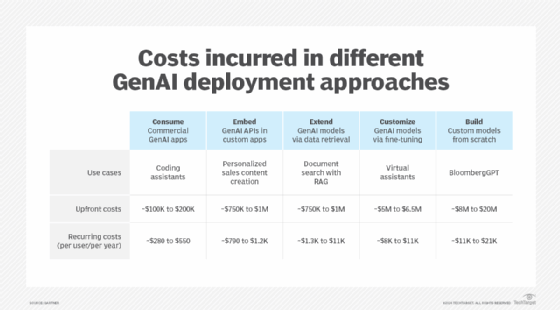
your123 - stock.adobe.com
Enterprises struggle to find business value with GenAI
Enterprises chase an impractical immediate payback from GenAI and miss opportunities to use less expensive machine learning to solve problems, experts say.
Many enterprises will abandon early-stage generative AI projects in the coming months due to poor preparation or insufficient business value. To avoid wasting money on unfocused initiatives, experts recommend clearly defining the problem and integrating GenAI as part of an overall solution.
Enterprises start GenAI projects expecting an immediate payback rather than treating the technology as part of a long-term strategic goal, Gartner said in a report released this week. That mindset will contribute to at least a 30% abandonment rate for current proof-of-concept projects by the end of 2025.
Other contributing factors include not having data adequately prepared for use in GenAI models and failing to ensure the models will respond to queries accurately and without bias. Escalating costs and fuzzy business value also add to the chances of dropping GenAI projects.
Disillusionment with GenAI can stem from enterprises misunderstanding the best use for the technology and failing to define a problem clearly, experts said. Often, enterprises can solve the problem with traditional predictive AI, which is magnitudes less expensive than deploying GenAI.
"We have seen more and more that there are a whole bunch of problems where more traditional predictive AI algorithms tend to be more accurate," said Sameer Maskey, CEO of Fusemachines. The company provides technology to help organizations in various industries use AI.
Predictive AI uses machine learning to analyze historical data and identify patterns of what's most likely to happen. Companies use that form of AI to determine future product demand and customer churn.
Frequently, CEOs and boards pressure CIOs into deploying GenAI instead of less expensive alternatives. Fueling that dynamic is the GenAI hype that fosters expectations of huge productivity gains from the technology.
"A company is not focusing enough on the ROI computation right in the beginning of the journey of an AI system implementation," Maskey said. "It is not thinking through whether it even needs GenAI."

Companies miss the big picture
Companies are also shortsighted about their use of GenAI, said Traci Gusher, data and analytics lead at global consulting firm EY. They use GenAI to improve one piece of a current business process instead of making it a part of a project to transform the whole process for maximum business value.
For example, a travel agency could use GenAI to help people find a flight, hotel and rental car, and use a robotic process automation bot to book everything and charge the credit card. An RPA bot is software that automates repetitive, rules-based tasks.
Another example is to use an ML-driven financial planning and forecasting agent to analyze historical buying data and market trends to guide placing orders in a supply chain, Gusher said. Analysts could use GenAI to drill down on reports and data when the agent's predictions are abnormal.
"A lot of organizations aren't thinking broadly enough about engineering the whole process," she said.
Using GenAI to transform business models won't come cheap. Gartner estimates that utilizing the technology for that purpose can cost from $5 million to $20 million.
Today, few companies are ready to spend big on GenAI, Gusher said.
"Most of the organizations that I'm seeing that have moved to production scale with generative AI use cases are still just dipping their toe in the water and getting incremental productivity," she said.
Those companies are the most prominent enterprises across industries ranging from healthcare and life sciences to energy, technology and financial services.
Antone Gonsalves is an editor at large for TechTarget Editorial, reporting on industry trends critical to enterprise tech buyers. He has worked in tech journalism for 25 years and is based in San Francisco. Have a news tip? Please drop him an email.







